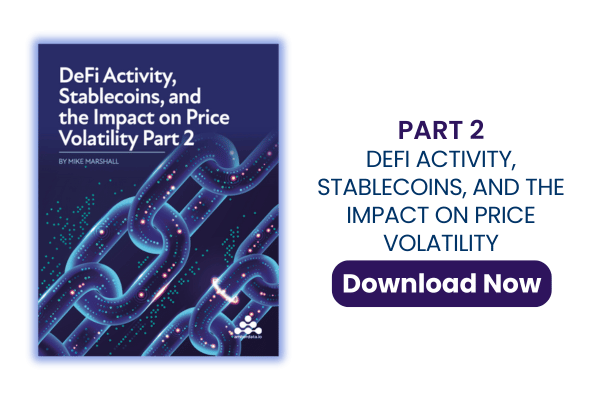
Deribit's "Crypto Options Unplugged" with the brilliant minds of David Brickell and Imran Lakha as hosts! Uncover deep insights, strategies, and the latest in crypto options. Don't miss this podcast episode featuring special guest Greg Magadini, Director of Derivatives at Amberdata, stay tuned for more!
This week on Crypto Options Unplugged, host David Brickell (FRNT Financial) is joined by Greg Magadini, Director of Derivatives at Amberdata, to discuss the sharp turmoil in equity markets following the announcement of Trump’s “Liberation Day” tariffs, which exceeded even the worst expectations. They also dive into Bitcoin’s surprising resilience: has it matured as a safe haven? From trading volatile markets to a special segment with Ethena Labs’ Guy Young and FalconX’s Josh Lim on the new yield-bearing USDE coin joining Deribit’s collateral pool, this episode unpacks strategies, macro risks, and crypto’s next moves.
Market Turmoil Triggered by Tariffs
Global equity markets plummeted this week as Trump’s "Liberation Day" tariffs exceeded even the worst-case scenarios, sparking widespread market volatility. Despite expectations that much of the bad news had been priced in, the sheer scale of the announcement caught markets off-guard, with the VIX briefly touching levels not seen since the COVID-19 crash and the 2008 financial crisis. Positioning was likely a major factor, as many investors appeared unprepared for the magnitude of the move. The result was a violent de-risking across asset classes, with equities seeing 5% down days back-to-back and a cascade of forced selling.
Bitcoin's Surprising Stability
Amid this turmoil, Bitcoin held up relatively well, even as it dipped below the $80,000 mark. Notably, its implied volatility (as measured by DVOL) remained muted compared to the extreme spikes seen in equity, bond, and gold markets. This has raised questions about whether Bitcoin is beginning to mature as a financial asset. The crypto market may have already de-risked ahead of equities, leading to a sense of seller exhaustion. Some observers are viewing this resilience as a sign that Bitcoin is being treated increasingly as a safe-haven asset—alongside gold—during times of extreme geopolitical or financial stress.
Positioning, Recession Risk & China’s Role
Global risk sentiment has turned sharply negative, with markets now pricing in rising recession risks due to escalating trade tensions. Much depends on China's response, as speculation grows about currency devaluation and potential treasury sales. Though actual treasury sales appear unlikely at this stage, China's recent currency fix beyond a key level has added fuel to volatility. Liquidity pressures from margin calls, rather than macroeconomic fundamentals, may be the driving force behind recent bond sell-offs.
Volatility Strategies & Market Outlook
Crypto derivatives markets, particularly in Bitcoin, are showing relatively low volatility despite the macro chaos, offering interesting opportunities for volatility traders. Short volatility strategies have become appealing in the near-term, though there’s caution around headline risk and the potential for sudden sentiment shifts. Bitcoin’s skew remains relatively balanced in longer-dated options, suggesting a lack of panic despite recent price declines. Traders are increasingly focused on tactical plays that balance both tail risks—the possibility of a broader crash and a major upside breakout fueled by geopolitical instability or shifts in institutional positioning.
Evolving Crypto Strategies Amid Market Uncertainty
The discussion explores how current volatility and market dynamics are creating a shift in crypto options trading strategies. Investors are leaning into "callers" — selling calls and buying puts — to protect the downside while still capturing potential upside. This reflects a growing institutional presence in crypto, leading to a structural decline in volatility as deeper-pocketed investors enter the space.
Institutional Impact on Crypto Volatility
With iBit reaching nearly 40% of Deribit’s volume, and institutions selling volatility to generate yield (e.g., buying BTC and selling covered calls), the market is experiencing a flatter skew and risk reversals. However, cyclical retail participation could still overpower these institutional flows during FOMO-driven rallies.
Macro Tail Risks and the Treasury Market
The conversation shifts to broader macro risks, particularly in the U.S. Treasury market. Concerns include potential international resistance to buying U.S. debt, weakness in long bonds, and unexpected market dislocations (e.g., fat finger trades). Geopolitical risks, including trade wars or crises in Japan, could impact U.S. Treasuries significantly.
Central Bank Intervention & Liquidity Support
The Fed and other central banks are expected to intervene amid Treasury market volatility. With quantitative tightening (QT) already tapered and proposals to ease leverage requirements on banks, central banks appear prepared to provide liquidity. The overall view is that financial repression will continue, supporting risk assets and ultimately benefiting Bitcoin.
Bitcoin’s Long-Term Bullish Thesis
Despite short-term volatility, the speakers maintain a bullish long-term outlook for Bitcoin. Central bank interventions and potential global recession risks are seen as setting the stage for a prolonged crypto cycle. Lower interest rates and increased fiscal stimulus, especially from China and potentially Europe, may further fuel asset inflation.
Timing Entry Points & Market Caution
Not all participants agree on immediate bullishness. Some express caution, preferring to wait for better entry points rather than buying near highs. Acknowledging crypto’s historical volatility, they anticipate significant pullbacks and believe stronger buying opportunities may lie ahead.
The Bigger Picture: Liquidity & Asset Inflation
Ultimately, the speakers converge on the idea that we remain in a fiat-debt-driven global system where asset inflation is necessary for economic expansion. Central banks, driven by necessity, will likely continue to inject liquidity, indirectly supporting Bitcoin and other risk assets over time.
Conclusion
While short-term volatility and macroeconomic uncertainty continue to shape tactical decisions, the broader crypto market appears structurally supported by long-term liquidity dynamics, institutional adoption, and macroeconomic tailwinds. The compression of volatility, increasing use of yield-generating option strategies, and quiet shifts in central bank posture suggest a regime where Bitcoin and crypto assets stand to benefit from financial repression and global demand for scarce, non-sovereign stores of value.
For investors, the key is navigating short-term noise while remaining positioned for structural upside. Hedged strategies, volatility-based entries, and patience during drawdowns may offer compelling risk-adjusted opportunities in what remains — by most macro and market signals — an ongoing bull cycle with cyclical bumps but secular momentum.
Amberdata
Amberdata is the leading provider of global financial infrastructure for digital assets. Our institutional-grade solutions deliver data, analytics and comprehensive tools and insights that empower financial institutions to research, trade, and manage risk and compliance in digital assets. Amberdata serves as a...
